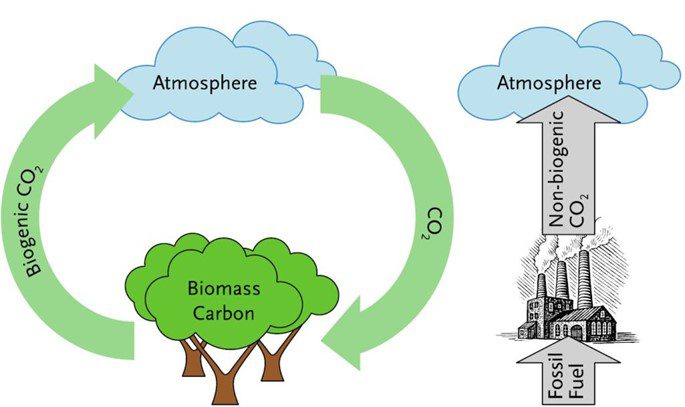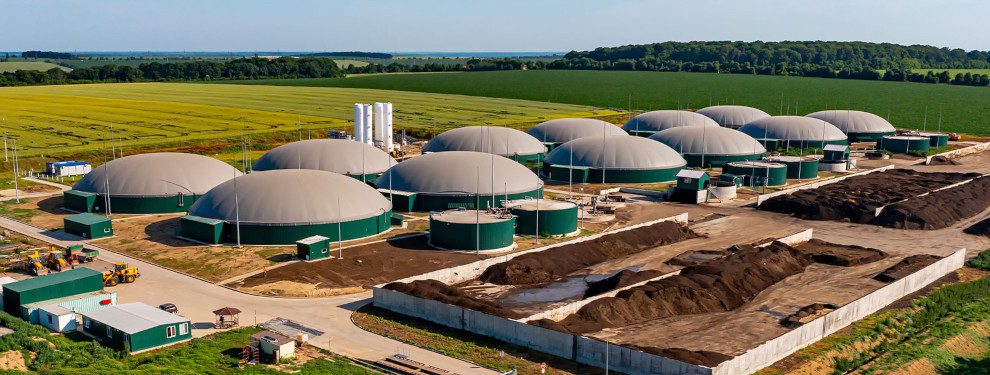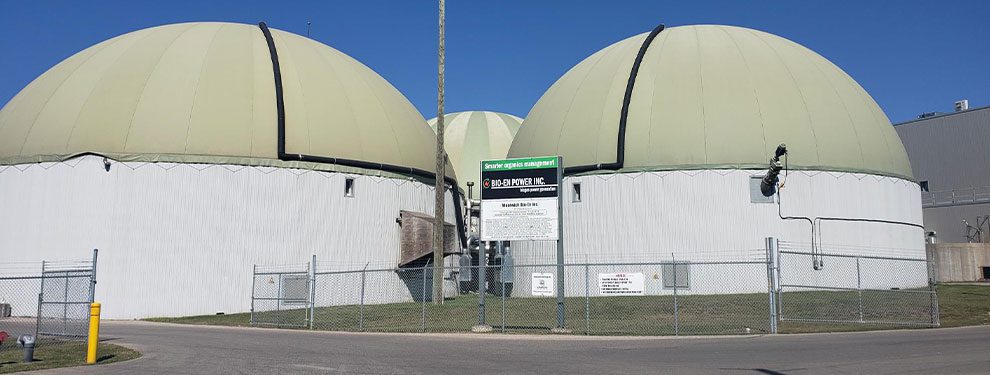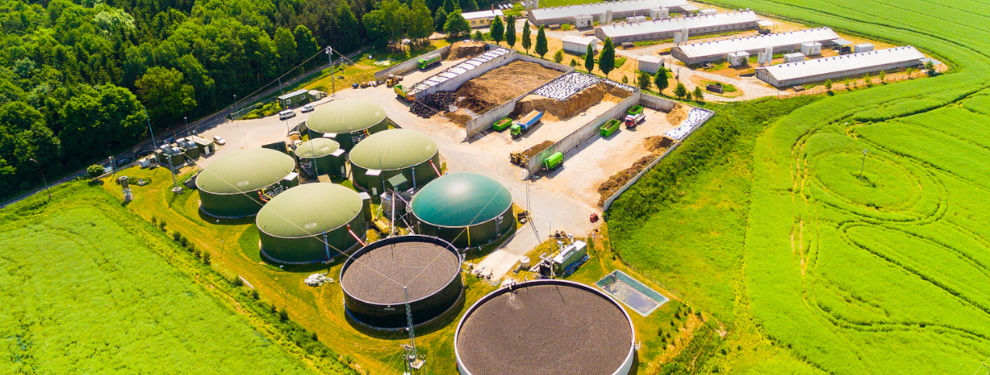
A potential game-changer in emissions reduction: All About Biogas Series, Article #3
March 30, 2022 Biogas
The first two articles in this series explored the market and regulations around biogas in Canada, and provided an overview of biogas technology. In this article we’ll look more closely at the environmental benefits of biogas from both a local and a global perspective, as well as how we can reduce some of the environmental risks that could arise from expanding biofuels globally.
Biogas can benefit the environment on a local and global scale
As discussed earlier in this series, the anaerobic digestion of organics has historically been as much about waste management as about energy. As a waste management system, biogas has an important role to play in helping municipalities extend the life of already-scarce landfill resources. Indeed, the Ontario Waste Management Association says the Province’s existing landfill capacity will be used up in little more than a decade.1 So the more organic waste we can divert to biogas the longer these landfills will be useful, which is especially critical for urban municipalities.
Managing waste, especially manure, is also important for farmers and their rural neighbours. Manure spreading is smelly business, but the anaerobic digestion of manure virtually eliminates its odours; the final processed material, called digestate, can be applied directly to fields and neighbours will hardly notice a smell. The digestate has higher value as a fertilizer too, as plants can take up nutrients from processed manure more easily, while the added organic matter builds and improves soils, with far less chemical leaching to pollute our waterways than unprocessed manure.
These local benefits are important, but with climate change being such a critical concern, the potential global emissions reductions of biogas are the key environmental impact. The two main gases to consider are carbon dioxide (CO2) and methane (CH4). While we’re very familiar with the role of fossil fuels in generating CO2, methane usually gets less attention, even though it is the second most impactful green house gas (GHG). Methane has around 80 times the warming impact per tonne of CO2 over 10-20 years, and has contributed around 30% of the net global warming due to GHGs since pre-industrial times,2 .
As with CO2, the fossil fuel sector is responsible for a large share of methane emissions, but agriculture and landfills are also major contributors; non-human sources are also considerable, especially wetlands, and – increasingly – melting permafrost.3 But the United Nations has said reducing human-caused methane emissions is “one of the most cost-effective strategies to rapidly reduce the rate of warming and contribute significantly to global efforts to limit temperature rise to 1.5°C.”4
The production of biogas through anaerobic digestion reduces global warming emissions in a number of ways. First, by taking in waste streams, it captures carbon that could otherwise form methane. Landfills, for example, are still responsible for some 20% of global anthropogenic methane emissions, despite the widespread use of “landfill gas” collection systems.5 When waste is instead processed in a biogas digester, the methane is burned and converted to CO2, which has a much lower global warming impact. Secondly, because it’s a renewable fuel, emissions are reduced when biogas replaces fossil natural gas in heating homes, powering vehicles, and in a range of industrial processes. Third, biogas can lower emissions indirectly by contributing dispatchable (on demand) electricity to the grid; as we’ll discuss further below, this can help smooth the transition to renewable energy and the replacement of fossil-fuelled electricity generation.
What makes biogas a renewable type of energy?
We’ve said that biogas offers a renewable fuel replacement for fossil-derived natural gas – but methane is methane, so what exactly does renewable mean here? Well, first we need to consider that fossil fuels are composed mainly of hydrocarbons made from the organic matter of ancient plants and animals. One of those hydrocarbons is methane (CH4), which we know also as “natural gas”. When these hydrocarbons are burned (in the presence of oxygen), most of this stored carbon is released in the form of carbon dioxide, the primary greenhouse gas. So natural gas contains ancient stored carbon that humans are mining, and releasing it to the atmosphere, where it contributes to global warming.
The methane in biogas also contains carbon. However, unlike with fossil fuels, this carbon has not been stored in the Earth for millions of years; the organic inputs to biogas systems hold carbon that has only recently been captured from the atmosphere by plants as they take up CO2 in their biomass. When this biomass is digested, and the resulting biogas is generated and burned, the carbon is simply returned to the atmosphere (this is referred to as biogenic CO2). Plants can immediately take up this carbon again, in a continuous exchange that results in a net-zero carbon relationship.

When purified to 95% or more methane, biogas becomes known as renewable natural gas (RNG) or biomethane, and can substitute for fossil natural gas on a 1:1 basis, with almost zero net carbon emissions. RNG can be blended with natural gas in pipelines and distribution systems and used in homes, industry, and vehicles. The potential is huge: natural gas provides close to 50% of space heating and 65% of water heating in Canadian homes, and this rises to more than 80% among Canadian businesses.7 The Alberta Resource Council has estimated some 1,200 billion cubic feet per year – equal to 36% of Canada’s 2017 natural gas consumption – could be provided as RNG.8 According to the International Energy Agency, fully utilizing the global biogas and biomethane potential could actually displace a full 20% of today’s worldwide natural gas demand.9
Achieving Climate Goals
Canada’s climate commitments were most recently stated in the 2020 plan titled A Healthy Environment and a Healthy Economy;10 they include a 30% reduction in emissions by 2030 (from a 2005 baseline), and achieving net zero carbon emissions by 2050. This is no small task, and it will require taking advantage of all our carbon reduction opportunities.
Biogas can have a positive impact on emission reduction in a wide range of industries and sectors where most GHGs arise.
- Oil and natural gas together generate around 26% of Canada’s GHG emissions. About a quarter of this amount arises from natural gas facilities, where leakage and flaring are major contributors.11
- Natural gas is used to generate around 11% of Canada’s electricity,12 but contributes almost one quarter of the GHGs arising from the electricity sector.13
- The transportation sector is responsible for around 25% of Canada’s GHG emissions.14 While natural gas powered vehicles use around 24% less emissions than gasoline, using RNG to fuel vehicles could reduce emissions by 60-80% from gasoline.15
- Canada’s landfills contribute around 4% of our global warming emissions, so the more we can divert organics from landfills, the closer we’ll be to our climate goals.16
When it comes to the larger global transition to renewable energy, biogas has a special role to play, because unlike other renewable energy sources, it can provide both base load as well as dispatchable power. This makes it a valuable complement to the expansion of other renewables like wind and solar, which generate power only intermittently. By contrast, biogas plants can run continuously to provide steady base load power around the clock. But as consumer demand rises or falls, grid operators need to adjust the energy supply. Since biogas can be stored and “fired up” in response to requests from the grid operator, it can provide a valuable service in helping maintain power levels in the grid, which helps the entire energy transition to proceed more smoothly. And like wind and solar, biogas plants are small and dispersed, which means that provide distributed generation; this offers modest additional benefits by reducing transmission losses.
It’s worth noting that with the environmentally inspired policy changes we looked at in part 1, including carbon taxes, clean fuel requirements, and incentives to lower carbon intensities in many industries, biogas doesn’t represent a cost to business so much as it presents an opportunity – and we believe investing in biogas and RNG should more than pay off. Analyst Brent Boss of Dillon Consulting, a local Toronto consulting firm, says “companies can actually lower their costs by investing in and buying RNG. The various incentives for RNG and hydrogen generation could even be more lucrative than the FIT program.”17
Best choices moving forward
While expanding biogas production offers many environmental benefits, we also need to watch out for potential pitfalls. Biogas operators must be aware that, since methane is so much more potent than CO2, even small amounts of leakage can erase the potential climate benefits of biogas..18 It’s also important to prioritize using waste materials, rather than dedicated crops, to minimize the land and food security impacts of biogas. The bioenergy sector – which includes not only biogas, but also bio-ethanol and wood/biomass – can have big impacts on land use. For example, when large areas of farmland and forest are turned to growing energy crops this can push agriculture into new areas, disrupting biodiversity and potentially removing existing carbon sinks. The proliferation of energy crops can also pose a threat to food security as markets vie for land and labour; over 1/3 of the United States corn crop is now consumed in ethanol production, largely in response to US clean fuel standards.19 Germany’s FIT program has led to some 14% of that nation’s farmland being diverted to energy crops.20 In effect, the bioenergy sector becomes one more mouth to feed.
Fortunately, biogas is the most efficient among the various bioenergy technologies on a per acre basis; one hectare can grow feedstock to generate enough biogas for 64,000 km of driving, which represents a 60-80% reduction in GHGs compared to gasoline.21 It can also digest the unusable wastes from other bioenergy systems like biodiesel and bioethanol, including crop residues, along with a wide range of post-consumer wastes. So biogas can provide more of the energy we need using less land. And much more could be done; the World Biogas Association reports that only 2% of biogas-viable wastes are being utilized worldwide, and it suggests that enthusiastic efforts to utilize biogas could ultimately reduce global GHG emissions by up to 10% by 2030.22 We believe taking advantage of this opportunity is among our best choices to secure global GHG reductions, and this promises biogas a big role in the future of clean energy.
References
- Ontario Waste Management Association (2020). “Ontario Needs New Landfills.” OWMA Statement, July 10. https://www.owma.org/articles/ontario-needs-new-landfills-1
- United Nations Environment Programme (2021). “Methane emissions are driving climate change. Here’s how to reduce them.” 20 August. https://www.unep.org/news-and-stories/story/methane-emissions-are-driving-climate-change-heres-how-reduce-them
- International Energy Agency (2021). “Methane and Climate Change”. https://www.iea.org/reports/methane-tracker-2021/methane-and-climate-change On permafrost, see Ellen Gray (2018). “Unexpected future boost of methane possible from Arctic permafrost”. August 20. https://climate.nasa.gov/news/2785/unexpected-future-boost-of-methane-possible-from-arctic-permafrost/
- United Nations Environment Programme and Climate and Clean Air Coalition (2021). Global Methane Assessment: Benefits and Costs of Mitigating Methane Emissions. Nairobi: United Nations Environment Programme, p. 5. https://www.ccacoalition.org/en/resources/global-methane-assessment-full-report
- United Nations Environment Programme and Climate and Clean Air Coalition (2021). Global Methane Assessment: Benefits and Costs of Mitigating Methane Emissions. Nairobi: United Nations Environment Programme, p. 28. https://www.ccacoalition.org/en/resources/global-methane-assessment-full-report
- IEA Bioenergy (2022). Fossil vs biogenic CO2 emissions [website].
- Natural Resources Canada (2017). North American Natural Gas Market: 2015-16 Heating Season Outlook [website]. July 25. https://www.nrcan.gc.ca/energy/sources/natural-gas/17894
- Canadian Gas Association (n.d.). The Renewable Natural Gas Opportunity [website]. https://www.cga.ca/natural-gas-101/the-renewable-natural-gas-opportunity/
- International Energy Agency (2020). Outlook for biogas and biomethane: Prospects for organic growth. March. https://www.iea.org/reports/outlook-for-biogas-and-biomethane-prospects-for-organic-growth.
- Government of Canada (2021). A Healthy Environment and a Healthy Economy [website]. April 8. https://www.canada.ca/en/services/environment/weather/climatechange/climate-plan/climate-plan-overview/healthy-environment-healthy-economy.html
- The data below can be found at Government of Canada (2021). Greenhouse Gas Emissions [website]. October 29. https://www.canada.ca/en/environment-climate-change/services/environmental-indicators/greenhouse-gas-emissions.html
- International Energy Agency (2022). Canada 2022: Policy Review. IEA Publications, January, p. 152. https://www.iea.org/reports/canada-2022
- Canada (2021), Greenhouse Gas Emissions.
- Canada (2021), Greenhouse Gas Emissions.
- IRENA (2018). Biogas for road vehicles: Technology brief. International Renewable Energy Agency, Abu Dhabi, pp. 41-42. https://www.irena.org/publications/2017/Mar/Biogas-for-road-vehicles-Technology-brief
- Government of Canada (2021). Greenhouse gas sources and sinks: executive summary 2021 [website], Table ES-2. https://www.canada.ca/en/environment-climate-change/services/climate-change/greenhouse-gas-emissions/sources-sinks-executive-summary-2021.html
- Brent Boss, Dillon Consulting, personal communication, May 12, 2021.
- Environmental Defense Fund (2019). “Not all biogas is created equal”. EDF Blogs, April 15. https://blogs.edf.org/energyexchange/2019/04/15/not-all-biogas-is-created-equal
- U.S. Department of Agriculture (2021). “Corn is America’s Largest Crop in 2019”. July 29. https://www.usda.gov/media/blog/2019/07/29/corn-americas-largest-crop-2019
- Fachagentur Nachwachsende Rohstoffe e. V. (2019). Bioenergy in Germany: Facts and Figures 2019, p. 10. http://www.fnr.de/fileadmin/allgemein/pdf/broschueren/broschuere_basisdaten_bioenergie_2018_engl_web_neu.pdf
- IRENA (2018), Biogas for road vehicles: Technology brief. International Renewable Energy Agency, Abu Dhabi, pp. 9, 37. https://www.irena.org/publications/2017/Mar/Biogas-for-road-vehicles-Technology-brief
- World Biogas Association (2021). “Biogas: Pathways to 2030, Executive Summary”, p. 3. https://www.worldbiogasassociation.org/executive-summary-preview/
About Skyline Clean Energy Fund
Skyline Clean Energy Fund (“SCEF”) is a privately owned and managed portfolio of medium to large scale clean energy assets, focused on acquiring income-producing assets across Canada, under long-term government contracts.
SCEF is offered as an alternative investment product through Skyline Wealth Management Inc. (“Skyline Wealth Management”), the exclusive Exempt Market Dealer (EMD) for SCEF.
SCEF is committed to surfacing value to its investors through asset monitoring and optimization, while providing a sustainable investment product based in clean, renewable energy.
To learn more about SCEF and its asset manager, Skyline Energy, please visit SkylineEnergy.ca.
To learn about additional alternative investment products offered through Skyline Wealth Management, please visit SkylineWealth.ca.
Skyline Clean Energy Fund is operated and managed by Skyline Group of Companies.
For media inquiries, please contact:
Cindy BeverlyVice President, Marketing & Communications
Skyline Group of Companies
5 Douglas Street, Suite 301
Guelph, Ontario N1H 2S8
cbeverly@skylinegrp.ca
More from this category:

The fuel to combat global climate change: All About Biogas Series, Article #1
By Rob Stein, Skyline Energy Hopes of a “green recovery” to pull the global economy out of its current pandemic-induced slump are on the minds of many governments around the world. In fact, the Organisation for Economic Co-operation and Development (OECD) now hosts a Green Recovery database that outlines hundreds of “environmentally positive recovery measures” [...]
Skyline Clean Energy Fund Purchases Biogas Facility
[Guelph, Ontario – August 24, 2021] On August 24, 2021, Skyline Clean Energy Fund (the “Fund”) purchased its first biogas clean energy asset. The 2.85 MW/DC1 biogas facility, located in Elmira, Ontario, was originally developed and built by Woolwich Bio-En Inc. (WBEI). Skyline Clean Energy Fund purchased an 80% stake in the facility for $43.2M. [...]

